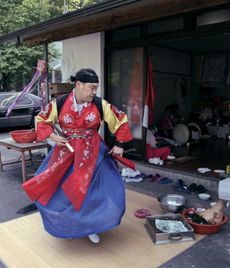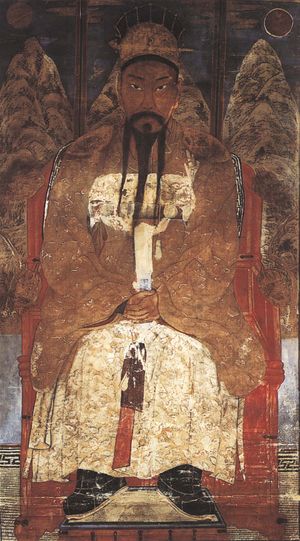الأساطير الكورية
 |
| جزء من سلسلة عن |
| ثقافة كوريا |
|---|
| التاريخ |
|
|
قالب:Korean shamanism Korean mythology refers to stories passed down by word of mouth over thousands of years on the Korean Peninsula.[1] These stories serve as creation myths about the world and origin myths about nature or the social world. Korean myths are often localized and concern specific villages or clans.[2]
The earliest Korean myths predate Buddhist, Confucian, and Taoist beliefs and are instead rooted in Korean shamanism.[3] Rituals that glorify shamanistic gods are central to the retelling of Korean shamanistic myths.[2]
Many ancient Korean shamanistic myths were lost following the rise of Confucianism, which stressed pragmatism and rationalism. Only a fraction of Korean myths believed to have existed in ancient times were ultimately documented by Confucian and Buddhist scholars, many of whom modified the stories to fit within their own belief systems.[1]
. . . . . . . . . . . . . . . . . . . . . . . . . . . . . . . . . . . . . . . . . . . . . . . . . . . . . . . . . . . . . . . . . . . . . . . . . . . . . . . . . . . . . . . . . . . . . . . . . . . . . . . . . . . . . . . . . . . . . . . . . . . . . . . . . . . . . . . . . . . . . . . . . . . . . . . . . . . . . . . . . . . . . . . .
Influence of Korean shamanism
Korean shamanism played a major role in the creation of ancient Korean myths.[4] Shamanistic myths are referred to as musoksinhwa (Hangul: 무속신화) and are recited as a part of rituals meant to protect humans and nature. A keungut (Hangul: 큰굿), meaning "grand ritual" is the archetypal Korean shamanistic ritual, and each of its twelve parts includes a bonpuri (Hangul: 본풀이), meaning a myth about a god.[5]
Creation myths
Creation myths explain how the world began and where people came from. They typically include a first man or first woman who is responsible for creating the world.[6]
Founding myths
Geonguksinhwa (Hangul: 건국신화) are myths that explain the founding of a nation. Korea's ancient founding myths often include a story about the union of a sky father and earth mother. Korea's medieval founding myths instead established that Korean rulers had divine lineage but were not deities themselves.[7]
Dangun
Afterworld myths
Chasa Bonpuri
Chasa Bonpuri (Hangul: 차사본풀이) is an underworld myth from Jeju Island.
Birth and childhood disease myths
Samsin Halmoni
Samsin Halmoni (Hangul: 삼신 할머니) is a shamanistic myth about the triple goddess of birth. After being seduced by a monk, her brothers threatened to kill her for bringing dishonor to their family. She hid in a cave, where she gave birth and was later freed by her mother, a shaman from heaven.[8]
Deities[9]
- Sansin - Mountain gods
- Munsin - Door god
- Teojusin
- Cheuksin
- Jowangsin
- Eopsin - Goddess of storage and wealth
- Yeomna - God of death
- Sosamshin - Goddess of the birth of cattle
- Seonangsin - Goddess of villages, boundaries, and wars
- Yongwang
- Nulgupjisin
- Dosumunjang - Creator God
- Cheonjiwang - Sky King of the Gods
- Bagiwang - Queen of the Earth
- Daebyeol - King of the Afterworld
- Sobyeol - King of the Human World
- Hwadeok Jingun - Fire God
- Gangrim - Leader of the Chasas
- Jibuwang - Afterworld God who give orders to chasa.
- Danggeum - Samsin
- Samseung Halmang - Samsin of Jejudo
- Jeoseung Halmang - Goddess who brings death to babies
- Sambuljeseok - Three fate gods, sons of Danggem
- Byeolsang - Pox Gods including Sonnimnes and Eojeontto
- Baridegi - see above
- Hallakgungi - see Igong Bonpuri
- Gameunjang - Goddess of 'Jeonsang' term that could be referred to 'Fate' or 'Former Life'
- Segyeongsin - see above
- Oneuli - Goddess of Time
- Honsuseongin - Gods who protect children from diseases
- Chilseongshin - God of Septentrions
- Gungsang - Sun God
- Myeongwol - Moon Goddess
- Yeonggam - Dokkaebi Gods
- Jijang - Goddess of misfortune
- Bonhyangdang - Village Guardians, Gwenegitto, Baramun, and Baekjo Agi are named Bonhyangdangs
- Samani - God of Lifespan[10]
- Gunung - war gods
- Yeongdeung - Goddess of Wind[11]
- Bugeun - God of sexual relationships[12]
- Gamheung - Father of all Gods[13]
- Geollipsin - Begger Gods[14]
Other mythical beings
- Korean dragon
- Gwishin
- Chollima - winged horse
- Kumiho - nine-tailed fox
- Dokkaebi - Mischievous sprits that appear at night.
- Imugi - lesser dragons
- Haetae - lion with scales and a horn on its head
- Bulgasari - iron-eating monster
- Samjoko - three legged bird that represents the sun
- Bulgae
- Samjokgu - three legged dog that leads people and distinguish kumihos [15]
- Samdugumi - Monstrous fox spirit of Jeju Island that has three heads and nine tails.[16]
انظر أيضاً
References
- ^ أ ب Hwang, Pae-Gang (2006). Korean Myths and Folk Legends. Translated by Han, Young-Hie; Kim, Se-Chung; Chwae, Seung-Pyong. Jain Publishing Company. pp. x–xx. ISBN 0895818566.
- ^ أ ب The National Folk Museum of Korea (South Korea) (2004). Encyclopedia of Korean Folk Literature. 길잡이미디어. pp. 21–23. ISBN 8928900840.
- ^ Leeming, David (2005). The Oxford Companion to World Mythology. Oxford University Press. p. 231. ISBN 0195156692.
- ^ خطأ استشهاد: وسم
<ref>غير صحيح؛ لا نص تم توفيره للمراجع المسماة:2 - ^ Lee, Sooja (2016-11-28). "Shamanic Mythology". Encyclopedia of Korean Folk Culture (in الإنجليزية). Retrieved 2017-12-12.
- ^ Leeming (2005), p. 84.
- ^ Cho, Hyunseol (2016-11-28). "Founding Myth". Encyclopedia of Korean Folk Culture (in الإنجليزية). Retrieved 2017-12-13.
- ^ Monaghan, Patricia (2014). Encyclopedia of Goddesses and Heroines. New World Library. p. 75. ISBN 1608682188.
- ^ 신동흔 (20 March 2014). 살아있는 한국 신화. 한겨레출판. pp. 647–659. ISBN 978-89-8431-792-5. Retrieved 19 January 2018.
- ^ http://terms.naver.com/entry.nhn?docId=1782713&cid=49258&categoryId=49258
- ^ http://terms.naver.com/entry.nhn?docId=2625643&cid=51955&categoryId=55526
- ^ http://terms.naver.com/entry.nhn?docId=1103627&cid=40942&categoryId=31603
- ^ http://terms.naver.com/entry.nhn?docId=1010362&cid=48179&categoryId=48244
- ^ http://terms.naver.com/entry.nhn?docId=1010191&cid=50222&categoryId=50227
- ^ http://terms.naver.com/entry.nhn?docId=2120739&cid=50223&categoryId=51051
- ^ http://terms.naver.com/entry.nhn?docId=1009995&cid=50222&categoryId=50227

